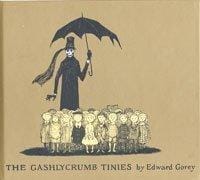The Gashlycrumb Tinies: Edward Gorey’s Macabre Alphabet
Discover why Edward Gorey’s darkly humorous alphabet book "The Gashlycrumb Tinies" remains a cult classic, blending macabre art, wit and social satire in just 26 couplets.

Introduction: A Delightfully Dark ABC
Few alphabet books have shocked, delighted and endured quite like Edward Gorey’s 1963 classic, The Gashlycrumb Tinies. While most primers teach children their ABCs through cheerful apples and bouncing balls, Gorey presents a roll call of diminutive Victorians meeting untimely ends: “A is for Amy who fell down the stairs, B is for Basil assaulted by bears.” The result is a wickedly humorous, meticulously illustrated tour de force that continues to intrigue readers of all ages.
Who Was Edward Gorey?
Edward St. John Gorey (1925–2000) was an American illustrator, writer and self-styled eccentric whose pen-and-ink drawings exude equal parts charm and menace. Sporting a fur coat in mid-summer and delighted by ballet as much as by morbid fiction, Gorey created more than 100 volumes of illustrated stories that straddle the line between children’s literature and Gothic satire. The Gashlycrumb Tinies remains his most recognizable work and a perfect distillation of his singular aesthetic.
The Book’s Structure: An Alphabet of Doom
At just 32 pages, the book follows a deceptively simple conceit: twenty-six children, each representing a letter, succumb to bizarre accidents or sinister fates. Every two-page spread features a single rhymed couplet in Gorey’s distinctive calligraphy alongside a monochrome drawing rendered in cross-hatched detail. The victims remain stoic, never screaming, which heightens the absurdity and underscores Gorey’s trademark understatement. The sparse wording and stark imagery invite the reader to linger on each tableau, filling in backstories that are never explicitly told.
Economy of Language
Gorey’s couplets average just six words, yet they conjure entire worlds: “C is for Clara who wasted away.” With no mention of time, place or motivation, Gorey relies on the reader’s imagination to supply the grim particulars. This minimalism contrasts sharply with the lush illustrations, illustrating how deft word economy can amplify visual storytelling.
Themes: Humor, Mortality and Moral Ambiguity
Why has a picture book about dead children retained its popularity? The answer lies in Gorey’s ability to balance horror with wit. He confronts mortality head-on, but the exaggerated nature of each demise—beheading, ennui, even spontaneous combustion—makes the subject matter surreal rather than traumatic. For adult readers, the book operates as a parody of Victorian morality tales in which children are punished for minor transgressions. Yet here, the deaths appear arbitrary, undercutting any tidy didacticism and poking fun at the notion of just deserts.
Subverting Didactic Tradition
Nineteenth-century cautionary stories, like Heinrich Hoffmann’s Der Struwwelpeter, aimed to scare kids into obedience. Gorey’s alphabet creates a similar structure but strips away explicit moral lessons, leaving only randomness. In doing so, he mirrors existentialist notions that life—and death—often lack reason, thereby inviting readers to question the fairness of the universe rather than the behavior of the children.
Artistic Style: The Power of Black and White
Rendered exclusively in black ink, Gorey’s illustrations use dense cross-hatching to produce texture, depth and an atmosphere of creeping fog. The Victorian costumes, Gothic architecture and cluttered interiors evoke an indeterminate past, both familiar and uncanny. By eliminating color, Gorey forces viewers to focus on composition, posture and facial expression—or the lack thereof. The children rarely show fear, which emphasizes the absurd calm that blankets the catastrophe. Collectors prize first editions for their crisp line work, but even modern reprints maintain the eerie allure.
Lettering as Design Element
The hand-drawn capitals are characters in their own right. Swirling serifs frame each illustration, guiding the eye in a clockwise motion that subtly encourages page turns. This integration of text and image predates contemporary graphic-novel storytelling techniques and cements Gorey’s reputation as both author and designer.
Cultural Impact and Legacy
The Gashlycrumb Tinies has influenced countless creators, from Tim Burton’s stop-motion animations to Lemony Snicket’s mock-Victorian prose. Its cult status extends to music videos, Halloween décor and even baby shower gag gifts. Libraries frequently shelve the book in the children’s section, prompting spirited debates about age appropriateness. Yet educators argue that Gorey’s macabre humor can spark conversations about poetry, illustration and the historical evolution of children’s literature.
Reading It with Modern Audiences
Parents and teachers who share the book with youngsters often provide context: Gorey does not celebrate violence but illuminates absurdity. Younger readers typically laugh at the rhymes without internalizing the morbidity, while older students analyze the social commentary. The key is to approach the text as a springboard for discussion rather than a moral blueprint. Pairing the book with alphabet lessons or creative-writing prompts can transform the shocking couplets into powerful teaching moments.
Collecting and Editions
First published by Simon & Schuster as part of The Vinegar Works boxed set, the book is now available in standalone hardcovers, paperbacks and digital formats. Signed first editions fetch high prices at auction, especially those with the original dust jacket. Limited fine-press editions introduce hand-colored plates, though purists prefer Gorey’s stark monochrome. Regardless of format, ensure the printing preserves the fine line work; blurred reproductions diminish the visual impact.
Conclusion: Why the Tinies Endure
Sixty years after publication, The Gashlycrumb Tinies remains a masterclass in concise storytelling, graphic design and dark comedy. By blending Victorian pastiche with modern existential wit, Edward Gorey created an alphabet book that refuses to be confined to childhood—or to any single genre. Whether approached as satire, art object or gleeful indulgence in the macabre, the book stands as an enduring reminder that literature can be both playful and profound, even when it begins with a tumble down the stairs.